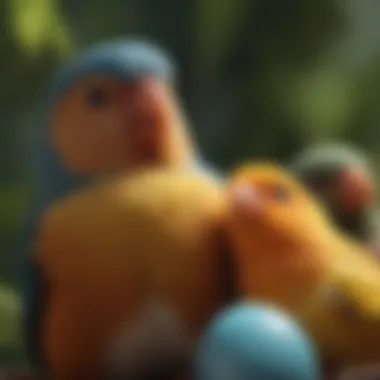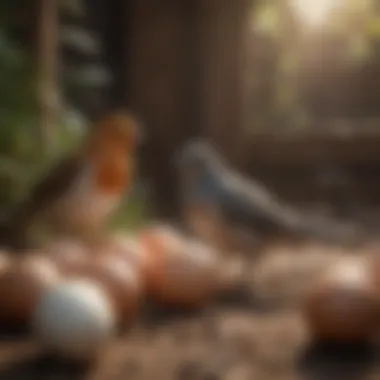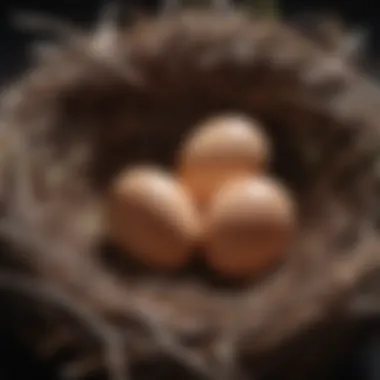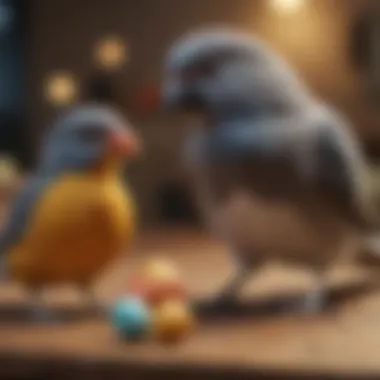Understanding Egg-Laying in Pet Birds: A Comprehensive Guide


Intro
Egg-laying in pet birds is a phenomenon that can be as complex as it is fascinating. For many bird owners, understanding this process is essential for ensuring the health and well-being of their feathered companions. Different species exhibit varied reproductive behaviors, and knowledge about what influences these behaviors is key.
This article will delve into the biological factors influencing egg-laying, environmental conditions that affect reproduction, and the behavioral aspects that play a significant role. Bird owners, whether novice or experienced, can benefit from insights into care, nutrition, and wellness concerning their birds' reproductive habits.
As we explore this topic, we aim to provide substantial depth in practical and insightful knowledge, enabling you to nurture and care for your pet birds more effectively.
Care Tips
Taking proper care of your pet bird is crucial, especially during egg-laying periods. Implementing daily care routines helps in monitoring their health and well-being. Bird owners should consider the following care aspects:
Daily Care Routines
- Ensure access to fresh water and food daily. A balanced diet supports reproductive health.
- Observe your bird's behavior daily to recognize potential changes that could indicate stress or health issues.
- Regular interaction helps to build trust and can mitigate stress related to egg production.
Cage Setup and Maintenance
- Provide a spacious cage; adequate room is vital for their comfort, particularly when laying eggs.
- Use absorbent bedding to make the cage sanitary and comfortable, reducing stress on your bird.
- Keep the surroundings quiet and calm. Avoid drastic changes during the egg-laying period to maintain a secure environment.
Hygiene and Cleaning Practices
- Separate nesting materials from a general area to avoid contamination.
- Clean the cage regularly, but do so gently during specific times when egg-laying behavior is noted to avoid stressing the birds.
Seasonal Care Adjustments
- Adjust feeding and care routines according to seasonal changes. Increased daylight during spring may trigger breeding behaviors.
- Monitor temperature and humidity to create an ideal setting for breeding and nesting activities.
Dealing with egg production is often multifaceted, and incorporating these strategies will promote a better quality of life for your pet bird.
Behavioral Insights
Understanding the behaviors of your pet bird is as importanf as nutrition and care routines. Bird behavior provides insights that signal their reproductive conditions and needs. Here are important behavioral aspects to consider:
Understanding Bird Body Language
Repairing the bird owners interpret their petsschuas behavior can significantly improve interaction and care:
- Tail position can signify alarm or contentment depending upon its state.
- A fluffed up appearance may indicate comfort or the need for warmth within your bird.
Common Behavioral Issues and Solutions
Birds can exhibit complications during nesting:
- Nesting aggression can be countered with calming techniques, such as covering the cage partially.
- If a bird is not laying eggs when expected, re-evaluate cage conditions or consult a vet regarding possible stress.
Positive Reinforcement Techniques
- Offer treats or verbal praise to encourage and normalized good behaviors, specifically those linked to laying eggs.
Social Interaction Needs
A sociable bird may feel less stressed if provided a companion, but if a bird displays too much aggression or stress, reassess such interactions and pairings.
In summary, being well-versed in behavioral signals translates into effective management of pets during the flourished time of egg-laying.
Nutrition Guides
Nutrition plays integral roles in predisposition and readiness for reproduction. Here are essential aspects to consider regarding feeding your birds:
Essential Diet Components
Feeding your pet birds requires a focus on their biological needs during egg production, which includes a varied diet of:
- Fresh fruits like berries and vegetables that help in maintaining energy levels and nutrients.
- Special seeds rich in fat and protein to help up the chances of healthy egg production is key.
Safe and Toxic Foods


Understand what alimentss are safe and toxic for your feathered friends:
- Safe: carrots, dandelions, cilantro.
- Toxic: chocolate, avocado, and caffeine.
Supplements and Treats
Consider incorporating calcium or vitamin supplements:
- Option like cuttlebone can enhance calcium levels, aiding in thick eggshells during the menace ordeal.
- Limited treats, such as nuts once or twice a week, support their morale.
Feeding Strategies for Different Species
- Adjust dietary strategies according to species needs. For example, a Cockatiel often needs to eat more fibers and veggies owingclarity to its natural behaviors.
These nutritional strategies can lay a significant foundation for healthier egg-laying phases and empower pet owners with adequate resources for better pet care.
Wellness and Health
Routine check-ups can not be underestimated, especially during the period leading up to the egg production. Timely medical insight may change the health redux for you bird:\n
Routine Health Checkups
Visit your vet periodically to spot early prevention of health issues associated with egg-laying stress or complications.
Identifying Symptoms of Illness
Watch for alterations in behavior as signals of underlying health influences on laying cycles. Symptom examples are:
- Further lethargy or forced positions outside normal.
- Decrease in appetite or unfamiliar feces characteristics.
Preventative Care and Vaccinations
Regular vaccinations prevent major diseases that can affect your bird's incubation ability directly, safeguard their wellbeing even in periods of natural reproduction risks.
Mental and Emotional Well-being
Be conscious of their psychological health alongside their physical health. Interactive elements such as puzzles or cozy playtime support both the individual welfare of your birds while promoting higher happiness levels during reproduction processes.
Enriching Activities
Stimulating engagements can heavily influence behaviors especially surrounding nervousness or anxiety during the time of egg-laying.
Toys and Playtime Ideas
Diverse items increase mental umethly-stimulationion.
- For example, with destructible boxes or mirrors, flipping items can draw adequate attention away from nesting areas if excessive attention becomes an issue.
Training and Tricks
Reinforcing skills engages them during periods of inevitability boring積-provision. Working often times broadens their mental workloads, leaving not too much effort directed further imposing elements as eggsorking patients.
Teaching simple commands might improve their natural behavior focusing to unaffected stress-optimization.
Outdoor Activities and Interaction
Supervisable outdoor bird mother searches can direct focus towards edifying channels, Off introducing fresh air newly presents experience rather pleasant which late can indicate stress. Monitoring create safe scenarios upon start tensions reduce therefore.
DIY Projects for Mental Stimulation
Fostering creativity through small enriching projects can ease nesting safety needs and emotional reflections. For mounting small pieces logically enhance their cognitive footprints. Completing compositions reward sight from thorough checks post-play, indicating reinforcement of their steady engagement leader roles.
By enriching interactive activities during the periods of laying eggs, an owner nurtures both the physical and mental environments significantly improving comfort and comprehension, unuiol outcome from holistic nurturing patterns.
In closing, understanding egg-laying behaviors in pet birds constructs a critical baseline towards better interactions and knowledge in care Android improve significantly overall pet experiences.
Do Pet Birds Lay Eggs?


Egg-laying is a significant aspect of pet bird behavior that merits close examination. Understanding this phenomenon is essential for bird owners, as it impacts both the health and management of their feathered companions. Knowing if and how pet birds lay eggs can shape a owner's approach towards care, ensuring the living environment suits their needs. Moreover, delving into the medical requirements and lifestyle adaptations associated with egg production promotes both the physical and mental well-being of birds.
Intro to Egg-Laying
Egg-laying is a natural biological process that commonly occurs within various species of birds. Contrary to popular belief, this behavior is not exclusive to wild habitats and can be observed in domesticated birds as well. Within the context of pet ownership, understanding egg-laying is vital. A thorough comprehension aids in recognizing behavioral patterns and potential health adjustments to accommodate a laying bird. Immediate attention to an egg-associated changes can prevent complications.
Species That Typically Lay Eggs
Common Pet Bird Species
Among the prevalent pet birds, species like budgerigars, cockatiels, and canaries are notable for laying eggs. These birds are popular for their sociability and appealing appearance. Budgerigars, or
The Biology of Egg Production
Understanding the biology of egg production is crucial for pet bird owners. It illuminates the mechanics that underpin the egg-laying process. Comprehending these biological functions can greatly enhance the ability to care for and manage pet birds effectively. Knowledge about these processes aids pet owners in recognizing normal versus abnormal behaviors and health issues when they arise. This understanding is pivotal for ensuring both the health of the bird and the peace of mind of the owner.
Reproductive Anatomy of Birds
The reproductive anatomy of birds varies significantly by species. However, some structures are generally consistent across many species. The key components typically include the ovaries, oviduct, and cloaca.
- Ovaries: Most female birds have only one functional ovary. The left ovary is often the one that remains active. There, ovum mature and the development can occur in cycles related to hormonal changes.
- Oviduct: After ovulation, the ovum travels down the oviduct. This tube is lined with glands that add layers to the egg, including the white and shell membranes. The passage is often divided into sections where specific layers form.
- Cloaca: The cloaca is the ending where both the reproductive and excretory systems meet. When the egg is ready to be laid, the cloaca contracts, pushing the egg out.
Knowing these components helps owners understand how the egg-laying process can be affected by health, nutrition, and environment.
Hormonal Influences
Hormonal influences play a significant role in egg production in birds. Different hormones regulate various stages from egg development to laying. The primary hormones involved include estrogen and progesterone.
- Estrogen: Promotes the growth of egg follicles. An increase indicates that a bird may be preparing to lay an egg.
- Progesterone: Following ovulation, progesterone levels rise to support the development of the yolk and egg membranes. High levels of this hormone sustain the reproductive cycle.
The balance of these hormones is intertwined with external factors like daylight length and environmental stressors. Erratic hormone levels may lead to multiple laid eggs or even health issues, demonstrating how integral this balance is to the overall reproductive health of pet birds.
Key point: Understanding the biology of the reproductive system in birds equips owners to manage their birds' egg-laying processes effectively.
Factors Influencing Egg-Laying
Understanding the factors that influence egg-laying is critical. It provides insight into the wellbeing and proper care of pet birds. Correct information about these influences helps bird owners create a responsible environment for their pets, making it easier to manage their needs surrounding reproduction.
Environmental Conditions
Temperature and Light Exposure
Temperature and light exposure are significant elements in the egg-laying process of birds. Birds are particularly sensitive to their environment. Both excessive heat and limited sunlight can unpredictably stimulate or inhibit reproductive behaviors. An optimum temperature ranges between 70 to 80 degrees Fahrenheit for many species. Proper lighting plays a critical role too. Birds need exposure to natural light cycles to maintain healthy hormonal levels. This natural cycle can encourage regular egg-laying patterns, making light exposure an essential consideration for owners. However, too much artificial light might confuse their biological clocks, leading to abnormal laying habits.
Nest Availability
Nest availability is accompanied by the structural aspect pet birds engage with. The presence of secure nesting materials can deeply impact whether a bird will lay eggs. Birds lean towards laying eggs in safe, secluded places that mimic their natural habitat. This impression of a safe environment largely determines if a bird will start nesting behavior. Placing a nest is not enough; it requires proper materials. However, excessive nest availability can lead to unintended matings and frequent egg-laying, making it vital for pet owners to monitor and manage their bird's nesting choices.
Dietary Considerations
Nutritional Requirements for Egg-Laying
Nutritional requirements for egg-laying vary among different bird species. Ensuring that a balanced and comprehensive diet is maintained is crucial. A diet inclusive of proteins and calcium fosters the appropriate healthiness needed during the egg-laying season. Correct nutrients assist in producing strong shells, reducing any fragile eggs. An awareness of several beneficial seed mixtures can aid this requirement. However, an excess of treat foods can lead to imbalanced nutrition, which may complicate reproductive health.
Impact of Imbalanced Diets
Imbalanced diets show considerable impact on egg production. Lack of vital nutrients can contribute to complications, such as sparse egg-laying or underdeveloped eggs. Pet owners must remain vigilant about their birds’ consumptive habits and potential drawbacks of certain parrot mixes. Neglecting nutrition can lead to severe ramifications for the overall well-being of pet birds during reproduction.
Stress and Health Factors
Effects of Stress on Reproduction
Stress emerges as a pivotal factor that zmay have harmful effects on reproduction. Elements causing stress in birds can vary from environmental noise to cage locations. Likewise, adjustments in habit and schedule may create discomfort leading to eventual behavioral changes. Recognizing stressors quickly is beneficial for maintaining a comfortable environment for birds. Reducing stress does not only foster better health but also encourages healthier forms of reproduction, which is essential.
Health Conditions That Affect Egg Production
Health conditions can dramatically affect the production of eggs in birds. Illness and underlying conditions must not be ignored, as they can reduce both the quantity and quality of eggs. Regular veterinary wellness checks ensure early detection and are fundamental practices bird owners must embrace. Early diagnosis allows for timely remedies that maintain health standards and influence better reproductive outcomes.


Understanding Egg-Laying Behavior
Understanding egg-laying behavior is crucial for pet bird owners. Recognizing how birds behave when they are about to lay eggs can aid in better management and care of your avian companions. This will lead to improved welfare and lessen the potential stress both for the birds and their owners. Comprehending nesting instincts and behavioral signs can enhance an owner's ability to respond appropriately. It can prepare owners for potential issues that may arise during an egg-laying cycle, thereby facilitating health monitoring and environmental enhancements.
Nesting Instincts
Nesting is a fundamental instinct for many species of birds. Even pet birds, raised in the comforts of a home, often display strong nesting behaviors. This instinct is deeply rooted in their evolutionary history. Birds instinctively search for safe places to lay eggs. Providing suitable nesting materials and environments can minimize stress for the bird. Often, female birds may exhibit specific behaviors like shredding paper or carrying materials to create a nest.
These nesting activities can come from parrots or finches, who are particularly known to express these instincts in captivity. It's important for owners to offer nesting options like small boxes or safe corners where birds can feel secure. Improper handling of these behaviors can lead to increased tension and anxiety in pet birds. Making necessary adaptations to their environment can help promote peace of mind, fostering a wholesome experience during the laying process.
Behavioral Signs of Laying
Recognizing behavioral signs of laying eggs is essential in anticipating the reproductive cycles of pet birds. These signs may vary between species but generally include changes in activity levels, vocalizations, and eating habits. Female birds might become more restless, seeking spaces to get comfortable and secure.
Additionally, watch for these key indicators:
- Increased preening: Birds may preen more than usual, preparing their feathers and bodies for nesting.
- Aggression: A bird might display more territorial behaviors or become more defensive of its perceived nest area.
- Changes in Diet: You may notice shifts in eating habits, such as decreased food intake during laying.
- Frequent visits to a particular spot: Birds may repeatedly return to the same location, indicating a chosen nesting area.
Being aware of these behaviors can help owners proactively manage the health and wellness of their birds during the laying phase. Prompt observation and appropriate response can prevent complications that may arise with egg-laying. Those little changes might seem insignificant but often speak volumes about a bird's reproductive status.
Note: Always ensure to monitor health throughout the entire egg-laying process.
By understanding these behavioral aspects deeply, enthusiast pet owners can provide better overall support and, consequently, an enriched experience for the birds in their care.
Implications for Bird Owners
Managing Egg-Laying
Successfully managing the egg-laying process involves both understanding behavior and preparing the environment. Pet birds, particularly female ones, may become obsessed with wanting to lay eggs. They can mimic natural instincts, which can lead to difficulty in managing parental behavior.
The first step in this management is to create an environment that doesn't stimulate excessive breeding behavior:
- Reduce Daylight Hours: Mimic natural conditions. Aim for about 10-12 hours of light.
- Limit Nesting Materials: If no nesting is encouraged, do not provide excessive materials. Too much can increase the urge to nest.
- Provide Behavior Diversions: Toys and other activities can channel their focus away from nesting. Rotate these regularly to keep them interesting.
Sometimes, egg-laying leads to over-breeding and other health issues. Owners must be prepared for such outcomes and recognize if the bird displays uncomfortable behaviors. These might include distress or moving restlessly. If cage conditions are responded poorly, consider consulting a veterinarian for advice.
Health Monitoring During and After Laying
When female birds lay eggs, health monitoring becomes paramount. Laying eggs is a significant stress on the bird's body, which requires adequate support and vigilance from the owner.
Key areas during and after the egg-laying period include:
- Weight and Diet Monitoring: Regularly check the bird’s weight and alter diet if necessary. Calcium and protein are essential to support the health of laying birds.
- Behavioral Changes: Look for signs of lethargy, aggression, or withdrawal. These can signify discomfort, part of normal behavior, or something else entirely.
- Post-Laying Care: After eggs have been laid, the pet must remain healthy. Ensure that any eggs that will not hatch are removed promptly. This will prevent potential health complications like egg binding.
Common Myths About Pet Birds and Egg-Laying
Understanding the misconceptions about egg-laying in pet birds is essential for several reasons. Many bird owners operate under false beliefs that could affect their birds' care, health, and well-being. Recognizing these myths allows owners to provide more informed and responsible care. This section addresses common misperceptions. We will uncover the reality behind each myth to guide bird owners more soundly.
Debunking Misconceptions
There are a number of widely held beliefs about pet birds and egg-laying that lack scientific backing. Here are some of the most prevalent:
- All female birds will lay eggs. This is incorrect. Not all female birds will lay eggs, especially if environmental factors do not trigger the behavior. Factors such as lack of a suitable nesting area or inadequate light conditions can inhibit this natural instinct.
- Pet birds' eggs are always fertile. Contrary to popular thoughts, many times eggs are productive because there is no male present, and thus, not fertilized. Owners assuming all laid eggs are viable may end up disappointed as they discover this isn’t indeed the case.
- Eggs benefit a bird's overall health. This misconception leads to many uninformed practices. While eggs provide certain nutrients, the stress related to egg-laying and potential health complications can outweigh any perceived dietary benefits when laying becomes excessive or unmeded.
- It is not necessary to help a bird if it is laying eggs. In some cases, female birds can suffer from difficulty while laying, which could lead to various health issues like egg binding—a dangerous condition. It is vital for bird owners to monitor their birds during this time.
- Presence of eggs means readiness for future breeding. Owning a female bird that has laid eggs does not automatically indicate breeding capacity or compatibility between mates. Factors affecting the desired process go beyond solely laying eggs, including compatibility, behaviors, and environment.
Bird owners must remain educated. Familiarity with these myths will help shape better practices for bird care and create healthier living conditions. Summarizing the key points and actions that need to be undertaken can go a long way. Awareness is crucial and a key part of responsible bird ownership.
"Always focus on education. Knowing the facts aids in providing proper care for pet birds and ensuring their health and happiness."
Epilogue
The conclusion of this article serves as a crucial component in understanding the dynamics of egg-laying among pet birds. This topic is relevant not just for enthusiasts but for all pet bird owners who wish to gain insights into the reproductive behaviors of their avian companions. Recognizing the nuances of egg-laying provides numerous benefits, helping owners make informed decisions regarding the care and management of their birds.
Key considerations include both the biological aspects of egg-laying and the implications for well-being. It becomes essential to maintain proper environmental conditions and nutritional requirements, while managing the stress levels of the birds. Owners equipped with this knowledge are more likely to create supportive habitats for their pets, leading to healthier, happier birds.
"Understanding the reproductive habits of pet birds is more than mere observation; it is part of being a responsible owner."
Comprehensively, the culmination of egg-laying behaviors explored throughout this article underlines not only a biological process but also an avenue for enhancing the understanding of avian health and welfare.
In summary, awareness of the factors influencing egg-laying, proper egg management techniques, and health considerations reinforces the owner's role in fostering a loving environment for their birds.
Summarizing Key Points
- Pet Birds and Egg-Laying: Most pet bird species have the capacity to lay eggs, which may not always correlate with the presence of a mate.
- Understanding Biology: The biology of egg production is intricate, comprising reproductive anatomy and hormonal influences that directly affect laying behavior.
- Influencing Factors: Environmental conditions, dietary needs, and health-related issues significantly impact not only the frequency of egg-laying but also the bird's overall health.
- Behavioral Insights: Distinguishing nesting instincts and recognizing behaviors related to laying aids in anticipating and managing any issues.
- Myths Debunked: Being aware of common misconceptions assists patrons in making educated decisions regarding care practices.
- Owner Responsibilities: Knowledge empowers pet owners to manage egg-laying responsibly, ensuring the welfare of their birds and anticipating any medical follow-up that may be required.
In essence, having a deeper understanding of these key points centered around egg-laying will not only enhance the experience as a bird owner but also ensure a healthier living environment for their feathered friends.















